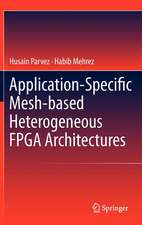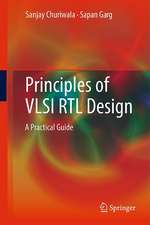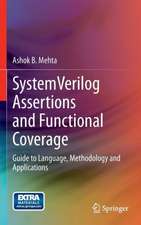The Verilog® Hardware Description Language
Autor Donald E. Thomas, Philip R. Moorbyen Limba Engleză Paperback – 5 noi 2012
| Toate formatele și edițiile | Preț | Express |
|---|---|---|
| Paperback (2) | 385.08 lei 6-8 săpt. | |
| Springer Us – 5 noi 2012 | 385.08 lei 6-8 săpt. | |
| Springer Us – 15 feb 2014 | 589.33 lei 6-8 săpt. | |
| Hardback (1) | 736.64 lei 6-8 săpt. | |
| Springer Us – 30 iun 2002 | 736.64 lei 6-8 săpt. |
Preț: 385.08 lei
Nou
Puncte Express: 578
Preț estimativ în valută:
73.71€ • 80.09$ • 61.96£
73.71€ • 80.09$ • 61.96£
Carte tipărită la comandă
Livrare economică 21 aprilie-05 mai
Preluare comenzi: 021 569.72.76
Specificații
ISBN-13: 9781461367840
ISBN-10: 1461367840
Pagini: 244
Ilustrații: XV, 223 p.
Dimensiuni: 155 x 235 x 13 mm
Greutate: 0.35 kg
Ediția:Softcover reprint of the original 1st ed. 1991
Editura: Springer Us
Colecția Springer
Locul publicării:New York, NY, United States
ISBN-10: 1461367840
Pagini: 244
Ilustrații: XV, 223 p.
Dimensiuni: 155 x 235 x 13 mm
Greutate: 0.35 kg
Ediția:Softcover reprint of the original 1st ed. 1991
Editura: Springer Us
Colecția Springer
Locul publicării:New York, NY, United States
Public țintă
ResearchCuprins
1. Verilog — A Tutorial Introduction.- 1.1 Describing Digital Systems.- 1.2 Getting Started.- 1.3 Module Hierarchy.- 1.4 Behavioral Modeling.- 1.5 Summary.- 1.6 Exercises.- 2. Behavioral Modeling Constructs.- 2.1 Process Model.- 2.2 If-Then-Else.- 2.3 Loops.- 2.4 Multi-way branching.- 2.5 Functions and Tasks.- 2.6 Summary.- 2.7 Exercises.- 3. Concurrent Process Statements.- 3.1 Concurrent Processes.- 3.2 Events.- 3.3 The Wait Statement.- 3.4 Disabling Named Blocks.- 3.5 Quasi-continuous assignment.- 3.6 Sequential and Parallel Blocks.- 3.7 Exercises.- 4. Logic Level Modeling.- 4.1 Introduction.- 4.2 Logic Gates and Nets.- 4.3 Continuous Assignment.- 4.4 Parameterized Definitions.- 4.5 Logic Delay Modeling.- 4.6 Delay Paths Across a Module.- 4.7 Summary.- 4.8 Exercises.- 5. Defining Gate Level Primitives.- 5.1 Combinational Primitives.- 5.2 Level- and Edge-Sensitive Sequential Primitives.- 5.3 Shorthand Notation.- 5.4 Mixed Level- and Edge-Sensitive Primitives.- 5.5 Summary.- 5.6 Exercises.- 6. Switch Level Modeling.- 6.1 A Dynamic MOS Shift Register Example.- 6.2 Switch Level Modeling.- 6.3 Ambiguous Strengths.- 6.4 Summary.- 6.5 Exercises.- 7. Two Large Examples.- 7.1 The miniSim Example.- 7.2 The 8251A Example.- 7.3 Exercises.- Appendix A. Lexical Conventions.- A.1 White Space and Comments.- A.2 Operators.- A.3 Numbers.- A.4 Strings.- A.5 Identifiers, System Names, and Keywords.- Appendix B. Verilog Operators.- B.1 Table of Operators.- B.2 Operator Precedence.- B.3 Operator Truth Tables.- B.3.1 Bitwise AND.- B.3.2 Bitwise OR.- B.3.3 Bitwise XOR.- B.3.4 Bitwise XNOR.- B.4 Expression Bit Lengths.- Appendix C. Verilog Gate Types.- C.1 Logic Gates.- C.2 BUF and NOT Gates.- C.3 BUFIF and NOTIF Gates.- C.4 MOS Gates.- C.5 Bidirectional Gates.- C.6 CMOS Gates.- C.7 Pullupand Pulldown Gates.- Appendix D. Registers, Memories, Integers, and Time.- D.1 Registers.- D.2 Memories.- D.3 Integers and Times.- Appendix E. System Tasks and Functions.- E.1 Display and Write Tasks.- E.2 Continuous Monitoring.- E.3 Strobed Monitoring.- E.4 File Output.- E.5 Simulation Time.- E.6 Stop and Finish.- E.7 Random.- Appendix F. Formal Syntax Definition.- F.1 Source Text.- F.2 Declarations.- F.3 Primitive Instances.- F.4 Module Instantiations.- F.5 Behavioral Statements.- F.6 Specify Section.- F.7 Expressions.- F.8 General.



















